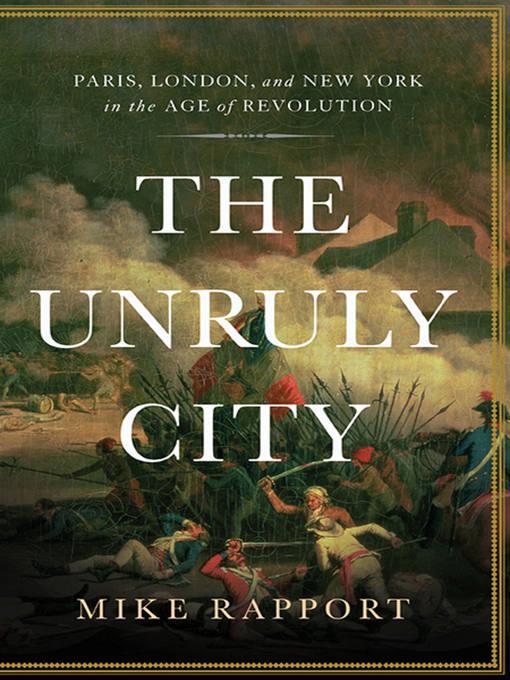
The Unruly City
Paris, London and New York in the Age of Revolution
کتاب های مرتبط
- اطلاعات
- نقد و بررسی
- دیدگاه کاربران
نقد و بررسی

Starred review from March 20, 2017
Rapport (1848: Year of Revolution), professor of history at the University of Glasgow, examines the political geography of dissent and revolution in three key Western cities, Paris, London, and New York, in the years 1763–1795. Of the three, Paris experienced the most extreme internal upheaval, and Rapport’s chapters on the French metropolis are his best. He shows, for example how certain neighborhoods, such as the Faubourg Saint-Antoine, became centers of political ferment and action. Rapport’s choice of New York is questionable, given that Boston was so significant in the American Revolution and New York was occupied by British troops from late 1776 to 1783. However, he shares insight on the nature of the popular uprising against the 1765 Stamp Act, a revolt against both the British and the city’s elites, and notes that, at the time of the Revolution, one-fifth of New York households “kept at least one slave.” Concerning London, Rapport shows that political activity was basically civil, excepting six days of anti-Catholic rioting in June 1780, and characterized as much by a “spontaneous tide of popular conservatism” in the city’s streets, coffee houses, and pubs as it was by reformist agitation. Rapport has combined academic scholarship with a well-paced, engaging writing style to produce an exceptional work of comparative late-18th-century political and urban history.

March 1, 2017
A history of the age of revolution in the Atlantic world's three largest cities.Throughout this eye-opening comparative history, Rapport (History/Univ. of Glasgow; Nineteenth-Century Europe, 2005, etc.) effectively explores "how groups and individuals lived through the revolutionary upheaval with all its anxieties, its stirring visions of the possible, its wrenching fear, its abject despair and seething hatred. The key point is that revolution is a human experience in all its exhilaration, terror and squalor." The author ably captures this experience, following the rise of the populace, those who were newly literate and learning from pamphlets and fliers now readily available due to the expansion of printers. They gathered in urban locales like pubs, taverns, and public meeting spaces across New York, Paris, and London, and they were alike in the blooming of suppressed anger. While London did not suffer a true revolution, the anger and demands for rights were still there. Rapport spots the differences in England's economic segregation and the strength of her loyalists, but there's a great deal more to it. All three cities were reeling under the costs of the Seven Years' War. France was literally broke, and England looked to her colonies to refill her coffers, resulting in the Stamp Act, the Tea Act, the Intolerables Act, and other tariffs that aroused the ire of the colonists. Though the cities couldn't be more different--in their topography, geography, culture, and class distinctions--the author points to the differences in a manner that allows readers to see how they did what they had to do to arrive at similar conclusions. The French had no history of free assembly, nor an elected legislature, not to mention few constitutional safeguards. One must wonder if the wide economic differences and suppressions led to the vast differences in the levels of violence. Rapport's in-depth research into these three cities at war is significant, the similarities and differences making the story all the more fascinating.
COPYRIGHT(2017) Kirkus Reviews, ALL RIGHTS RESERVED.

May 15, 2017
In an age of upheaval, revolutionaries and radicals in three cities effectively used the cityscape to mobilize popular action toward opening politics to broader, popular participation. How did geography, culture, buildings, and social institutions in Paris, London, and New York figure into the high drama of the American and French Revolutions, asks Rapport (history, Univ. of Glasgow; 1848: The Year of Revolution). These cities were the hubs of economic, political, and social authority and power between 1763 and 1795. Amid their cityscapes, the spaces and buildings, both physically and symbolically, became intertwined with the political and social disruptions of the era. However, more than a narrative of physical places and structures, this work is a complex, dynamic story of the struggle for democratic change in the communities of these metropolises. Artisans, laborers, and shopkeepers were active players in the revolutionary experience, and major differences in responses to provocations in these movements ensured divergent social and cultural outcomes. VERDICT A fascinating account for readers interested in the history of two North Atlantic super powers of the 18th century. Rapport successfully shows how place and ideas mix to affect profound change.--Glen Edward Taul, Campbellsville Univ. Lib., KY
Copyright 2017 Library Journal, LLC Used with permission.

























دیدگاه کاربران